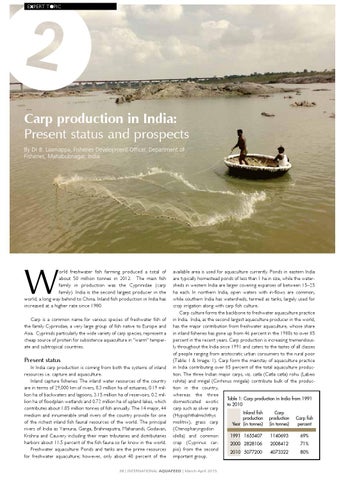EXPERT T●PIC
Carp production in India: Present status and prospects By Dr B. Laxmappa, Fisheries Development Officer, Department of Fisheries, Mahabubnagar, India
W
orld freshwater fish farming produced a total of about 50 million tonnes in 2012. The main fish family in production was the Cyprinidae (carp family). India is the second largest producer in the world, a long way behind to China. Inland fish production in India has increased at a higher rate since 1980. Carp is a common name for various species of freshwater fish of the family Cyprinidae, a very large group of fish native to Europe and Asia. Cyprinids particularly the wide variety of carp species, represent a cheap source of protein for subsistence aquaculture in “warm” temperate and subtropical countries.
Present status
In India carp production is coming from both the systems of inland resources i.e. capture and aquaculture. Inland capture fisheries: The inland water resources of the country are in terms of 29,000 km of rivers, 0.3 million ha of estuaries, 0.19 million ha of backwaters and lagoons, 3.15 million ha of reservoirs, 0.2 million ha of floodplain wetlands and 0.72 million ha of upland lakes, which contributes about 1.05 million tonnes of fish annually. The 14 major, 44 medium and innumerable small rivers of the country provide for one of the richest inland fish faunal resources of the world. The principal rivers of India as Yamuna, Ganga, Brahmaputra, Mahanandi, Godavari, Krishna and Cauvery including their main tributaries and distributaries harbors about 11.5 percent of the fish fauna so far know in the world. Freshwater aquaculture: Ponds and tanks are the prime resources for freshwater aquaculture; however, only about 40 percent of the
available area is used for aquaculture currently. Ponds in eastern India are typically homestead ponds of less than 1 ha in size, while the watersheds in western India are larger covering expanses of between 15–25 ha each. In northern India, open waters with in-flows are common, while southern India has watersheds, termed as tanks, largely used for crop irrigation along with carp fish culture. Carp culture forms the backbone to freshwater aquaculture practice in India. India, as the second largest aquaculture producer in the world, has the major contribution from freshwater aquaculture, whose share in inland fisheries has gone up from 46 percent in the 1980s to over 85 percent in the recent years. Carp production is increasing tremendously throughout the India since 1991 and caters to the tastes of all classes of people ranging from aristocratic urban consumers to the rural poor (Table: 1 & Image: 1). Carp form the mainstay of aquaculture practice in India contributing over 85 percent of the total aquaculture production. The three Indian major carps, viz. catla (Catla catla) rohu (Labeo rohita) and mrigal (Cirrhinus mrigala) contribute bulk of the production in the country, whereas the three Table 1: Carp production in India from 1991 domesticated exotic to 2010 carp such as silver carp Inland fish Carp (Hypophthalmichthys production production Carp fish molitrix), grass carp Year (in tonnes) (in tonnes) percent (Ctenopharyngodon idella) and common 1991 1655407 1140693 69% crap (Cyprinus car2000 2828106 2008412 71% pio) from the second 2010 5077200 4073322 80% important group.
38 | INTERNATIONAL AQUAFEED | March-April 2015
